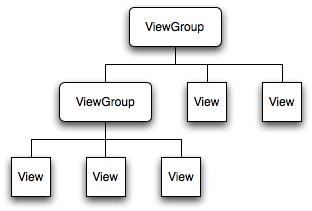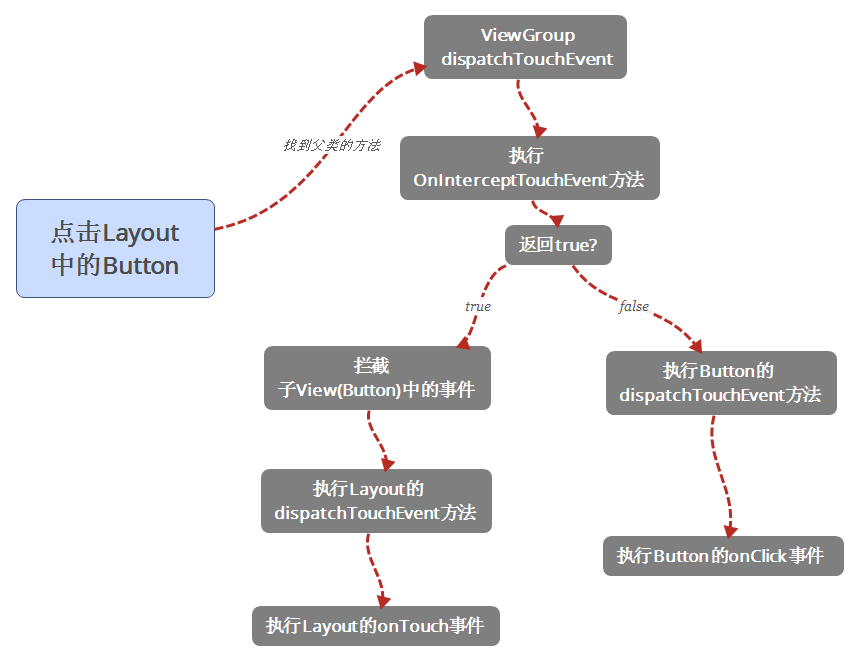上一篇博客 Android触屏分发机制(一) http://blog.csdn.net/u010429311/article/details/50978987
在上一篇博客中讲到了Button的点击事件处理,即View的点击事件是如何分发的,那么这篇文章更深入的理解触屏分发机制,讲述ViewGroup是如何实现的。大家可能都知道各种布局如RelativeLayout,LinearLayout都是继承自ViewGroup,简单来说它是View的集合,就像一个RelativeLayout包含了许多控件一样。其关系如图所示。

关于ViewGroup和View的具体信息,可以在百度里找到大量的资料。
回到正题,ViewGroup是如何实现触屏分发机制的呢?同样,先做一个测试:
Button btn = (Button) findViewById(R.id.button);
btn.setOnClickListener(new View.OnClickListener() {
@Override
public void onClick(View v) {
Log.i(TAG, "on click");
}
});
RelativeLayout layout = (RelativeLayout) findViewById(R.id.layout);
layout.setOnTouchListener(new View.OnTouchListener() {
@Override
public boolean onTouch(View v, MotionEvent event) {
Log.i(TAG, "layout on touch");
return false;
}
});当我们分别点击Button和Button外的空白处时,分别输出了两个结果:


我们可以看到,当点击按钮时layout的onTouch事件并没有执行!为什么作为ViewGroup的RelativeLayout没有执行onTouch事件呢?上一节讲到了当按钮点击时会执行其dispatchTouchEvent()方法,同样我们可以看看ViewGroup是如何实现其dispatchTouchEvent()方法的:
@Override
public boolean dispatchTouchEvent(MotionEvent ev) {
//省略一部分
final boolean intercepted;
if (actionMasked == MotionEvent.ACTION_DOWN
|| mFirstTouchTarget != null) {
final boolean disallowIntercept = (mGroupFlags & FLAG_DISALLOW_INTERCEPT) != 0;
if (!disallowIntercept) {
intercepted = onInterceptTouchEvent(ev);
ev.setAction(action); // restore action in case it was changed
} else {
intercepted = false;
}
} else {
// There are no touch targets and this action is not an initial down
// so this view group continues to intercept touches.
intercepted = true;
}
// If intercepted, start normal event dispatch. Also if there is already
// a view that is handling the gesture, do normal event dispatch.
if (intercepted || mFirstTouchTarget != null) {
ev.setTargetAccessibilityFocus(false);
}
// Check for cancelation.
final boolean canceled = resetCancelNextUpFlag(this)
|| actionMasked == MotionEvent.ACTION_CANCEL;
// Update list of touch targets for pointer down, if needed.
final boolean split = (mGroupFlags & FLAG_SPLIT_MOTION_EVENTS) != 0;
TouchTarget newTouchTarget = null;
boolean alreadyDispatchedToNewTouchTarget = false;
if (!canceled && !intercepted) {
// If the event is targeting accessiiblity focus we give it to the
// view that has accessibility focus and if it does not handle it
// we clear the flag and dispatch the event to all children as usual.
// We are looking up the accessibility focused host to avoid keeping
// state since these events are very rare.
View childWithAccessibilityFocus = ev.isTargetAccessibilityFocus()
? findChildWithAccessibilityFocus() : null;
if (actionMasked == MotionEvent.ACTION_DOWN
|| (split && actionMasked == MotionEvent.ACTION_POINTER_DOWN)
|| actionMasked == MotionEvent.ACTION_HOVER_MOVE) {
final int actionIndex = ev.getActionIndex(); // always 0 for down
final int idBitsToAssign = split ? 1 << ev.getPointerId(actionIndex)
: TouchTarget.ALL_POINTER_IDS;
// Clean up earlier touch targets for this pointer id in case they
// have become out of sync.
removePointersFromTouchTargets(idBitsToAssign);
final int childrenCount = mChildrenCount;
if (newTouchTarget == null && childrenCount != 0) {
final float x = ev.getX(actionIndex);
final float y = ev.getY(actionIndex);
// Find a child that can receive the event.
// Scan children from front to back.
final ArrayList<View> preorderedList = buildOrderedChildList();
final boolean customOrder = preorderedList == null
&& isChildrenDrawingOrderEnabled();
final View[] children = mChildren;
for (int i = childrenCount - 1; i >= 0; i--) {
final int childIndex = customOrder
? getChildDrawingOrder(childrenCount, i) : i;
final View child = (preorderedList == null)
? children[childIndex] : preorderedList.get(childIndex);
// If there is a view that has accessibility focus we want it
// to get the event first and if not handled we will perform a
// normal dispatch. We may do a double iteration but this is
// safer given the timeframe.
if (childWithAccessibilityFocus != null) {
if (childWithAccessibilityFocus != child) {
continue;
}
childWithAccessibilityFocus = null;
i = childrenCount - 1;
}
if (!canViewReceivePointerEvents(child)
|| !isTransformedTouchPointInView(x, y, child, null)) {
ev.setTargetAccessibilityFocus(false);
continue;
}
newTouchTarget = getTouchTarget(child);
if (newTouchTarget != null) {
// Child is already receiving touch within its bounds.
// Give it the new pointer in addition to the ones it is handling.
newTouchTarget.pointerIdBits |= idBitsToAssign;
break;
}
resetCancelNextUpFlag(child);
if (dispatchTransformedTouchEvent(ev, false, child, idBitsToAssign)) {
// Child wants to receive touch within its bounds.
mLastTouchDownTime = ev.getDownTime();
if (preorderedList != null) {
// childIndex points into presorted list, find original index
for (int j = 0; j < childrenCount; j++) {
if (children[childIndex] == mChildren[j]) {
mLastTouchDownIndex = j;
break;
}
}
} else {
mLastTouchDownIndex = childIndex;
}
mLastTouchDownX = ev.getX();
mLastTouchDownY = ev.getY();
newTouchTarget = addTouchTarget(child, idBitsToAssign);
alreadyDispatchedToNewTouchTarget = true;
break;
}
// The accessibility focus didn't handle the event, so clear
// the flag and do a normal dispatch to all children.
ev.setTargetAccessibilityFocus(false);
}
if (preorderedList != null) preorderedList.clear();
}
//省略一部分
}已经省略一部分了,代码还是有点长。我们看到第9行中这句代码
intercepted = onInterceptTouchEvent(ev)中的 onInterceptTouchEvent()方法,该方法很简单:
public boolean onInterceptTouchEvent(MotionEvent ev) {
return false;
}Intercept为“拦截的意思”,顾名思义,我们可以联想到分发事件的拦截。经过测试,可以知道,到返回值为true时,拦截分发,点击RelativeLayout中的Button无法响应,只输出了RelativeLayout的onTouch事件。了解了这个方法后,我们继续回到之前的dispatchTouchEvent()方法:
我们看到34行: if (!canceled && !intercepted),当onInterceptTouchEvent()方法返回false时,可通过该条件,然后跳到65行里的for循环,该循坏是遍历ViewGroup中所有的子ViewGroup或是View,找到用户所点击的View,并在第89行赋值newTouchTarget = getTouchTarget(child)。
之后我们在跳到98行的 if (dispatchTransformedTouchEvent(ev, false, child, idBitsToAssign))这个条件语句,再看看 idispatchTransformedTouchEvent(ev, false, child, idBitsToAssign)这个方法实现方式:
private boolean dispatchTransformedTouchEvent(MotionEvent event, boolean cancel,
View child, int desiredPointerIdBits) {
final boolean handled;
// Canceling motions is a special case. We don't need to perform any transformations
// or filtering. The important part is the action, not the contents.
final int oldAction = event.getAction();
if (cancel || oldAction == MotionEvent.ACTION_CANCEL) {
event.setAction(MotionEvent.ACTION_CANCEL);
if (child == null) {
handled = super.dispatchTouchEvent(event);
} else {
handled = child.dispatchTouchEvent(event);
}
event.setAction(oldAction);
return handled;
}
//省略一部分
}
幸运!我们终于在第13行中看到了child.dispatchTouchEvent(event)这句话,明显如果找到了点击控件child不为null,执行该语句。即回到了上一节所讲的View的dispatchTouchEvent()方法的触屏分发机制。
至此,ViewGroup的触屏分发机制也清晰了。最后,画个图总结一下:

























 7118
7118

 被折叠的 条评论
为什么被折叠?
被折叠的 条评论
为什么被折叠?








